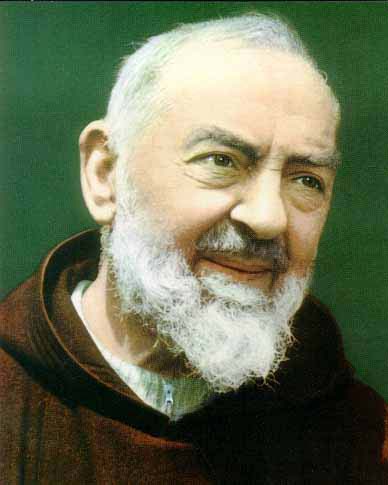 Francesco Forgione, later known as Padre Pio, (May 25, 1887 – September 23, 1968), canonized by Pope John Paul II in 2002 as Saint Pio of Pietrelcina, was an Italian Roman Catholic Capuchin priest who was given the name Pio when he joined the Order of Friars Minor Capuchin, and became popularly known as Padre Pio after his ordination to the priesthood. He became famous for his gift for reading consciences while hearing confessions, and for his stigmata. From 1916 to his death, he remained in the monastery of San Giovanni Rotondo.
Francesco Forgione, later known as Padre Pio, (May 25, 1887 – September 23, 1968), canonized by Pope John Paul II in 2002 as Saint Pio of Pietrelcina, was an Italian Roman Catholic Capuchin priest who was given the name Pio when he joined the Order of Friars Minor Capuchin, and became popularly known as Padre Pio after his ordination to the priesthood. He became famous for his gift for reading consciences while hearing confessions, and for his stigmata. From 1916 to his death, he remained in the monastery of San Giovanni Rotondo.
Stigmata are bodily marks, sores, or sensations of pain in locations corresponding to the crucifixion wounds of Jesus. The first well-documented case and the first to be accepted by Church authorities as authentic, was that of Saint Francis of Assisi (1182–1226), who first experienced stigmata in La Verna, Italy, in 1224. Saint Francis, however, was not a priest, but only a Brother; Padre Pio, worthy follower of St. Francis, was the first known priest in the history of the Church to bear the stigmata.
Padre Pio died on September 23, 1968. His body was buried three days later, in a crypt in the Church of Our Lady of Grace, in San Giovanni Rotondo. His funeral was attended by over 100,000 people. He was often heard to say, "After my death I will do more. My real mission will begin after my death". The accounts of those who stayed with Padre Pio till the end state that the stigmata had completely disappeared without even leaving a scar. Only a red mark "as if drawn by a red pencil" remained on his side which then disappeared.
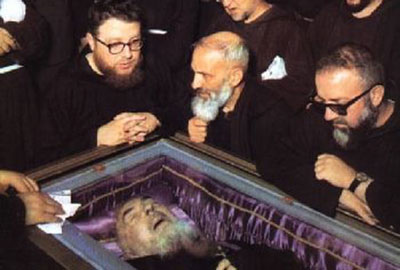 On March 3, 2008 the body of Saint Pio was exhumed from his crypt (see picture), 40 years after his death, so that his remains could be prepared for display. A church statement described the body as being in "fair condition". Archbishop Domenico D’Ambrosio, papal legate to the shrine in San Giovanni Rotondo, stated "the chin is perfect and the rest of the body is well preserved".
On March 3, 2008 the body of Saint Pio was exhumed from his crypt (see picture), 40 years after his death, so that his remains could be prepared for display. A church statement described the body as being in "fair condition". Archbishop Domenico D’Ambrosio, papal legate to the shrine in San Giovanni Rotondo, stated "the chin is perfect and the rest of the body is well preserved".
José Cardinal Saraiva Martins, prefect for the Congregation for the Causes of the Saints, celebrated Mass for 15,000 devotees on April 24 at the Shrine of Holy Mary of Grace, San Giovanni Rotondo, before the body went on display in a crystal, marble, and silver sepulcher in the crypt of the monastery. (See picture.) Padre Pio is wearing his brown Capuchin habit with a white silk stole embroidered with crystals and gold thread. His hands hold a large wooden cross. So far over one million pilgrims worldwide, mostly from Italy, have viewed the body; officials extended the display through September, 2009. One can read in the biography of Padre Pio on the website of the Vatican:
"Like the Apostle Paul, Padre Pio of Pietrelcina placed at the centre of his life and apostolic work the Cross of his Lord as his strength, his wisdom and his glory. Inflamed by love of Jesus Christ, he became like Him in the sacrifice of himself for the salvation of the world. In his following and imitation of the Crucified Christ he was so generous and perfect that he could have said: ‘I have been crucified with Christ; it is no longer I who live, but Christ who lives in me’ (Gal 2:20). And the treasures of grace which God had granted him so lavishly and unceasingly he passed on through his ministry, serving the men and women who came to him in ever greater numbers, and bringing to birth an immense host of spiritual sons and daughters.
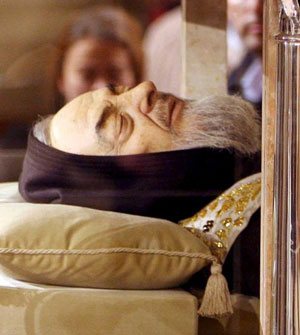 "Filled with love of God and love of neighbour, Padre Pio lived to the full his vocation to work for the redemption of man, in accordance with the special mission which marked his entire life and which he exercised through the spiritual direction of the faithful: the sacramental reconciliation of penitents and the celebration of the Eucharist. The pinnacle of his apostolic activity was the celebration of Holy Mass. The faithful who took part witnessed the summit and fullness of his spirituality.
"Filled with love of God and love of neighbour, Padre Pio lived to the full his vocation to work for the redemption of man, in accordance with the special mission which marked his entire life and which he exercised through the spiritual direction of the faithful: the sacramental reconciliation of penitents and the celebration of the Eucharist. The pinnacle of his apostolic activity was the celebration of Holy Mass. The faithful who took part witnessed the summit and fullness of his spirituality.
"Even during his lifetime, he enjoyed a vast reputation for sanctity, because of his virtues, his spirit of prayer, sacrifice and total dedication to the good of souls. In the years following his death, his reputation for sanctity and miracles grew steadily, and became established in the Church, all over the world and among all kinds of people."
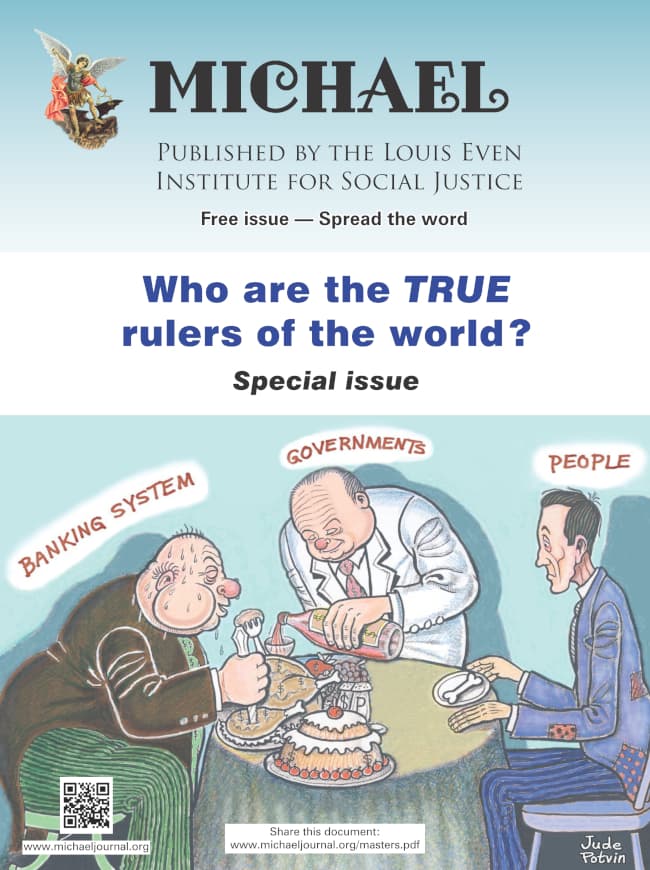 In this special issue of the journal, MICHAEL, the reader will discover who are the true rulers of the world. We discuss that the current monetary system is a mechanism to control populations. The reader will come to understand that "crises" are created and that when governments attempt to get out of the grip of financial tyranny wars are waged.
In this special issue of the journal, MICHAEL, the reader will discover who are the true rulers of the world. We discuss that the current monetary system is a mechanism to control populations. The reader will come to understand that "crises" are created and that when governments attempt to get out of the grip of financial tyranny wars are waged.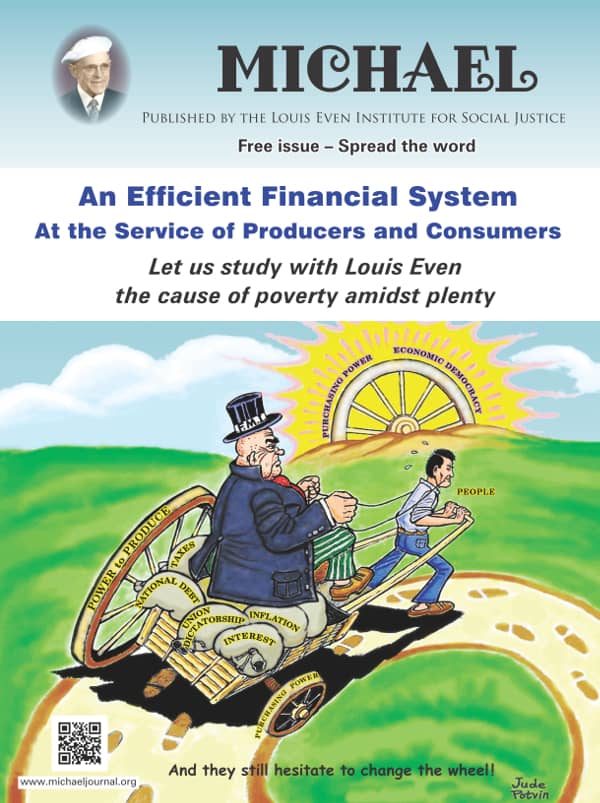 An Efficient Financial System, written by Louis Even, is for the reader who has some understanding of the Douglas Social Credit monetary reform principles. Technical aspects and applications are discussed in short chapters dedicated to the three propositions, how equilibrium between prices and purchasing power can be achieved, the financing of private and public production, how a Social Dividend would be financed, and, finally, what would become of taxes under a Douglas Social Credit economy. Study this publication to better grasp the practical application of Douglas' work.
An Efficient Financial System, written by Louis Even, is for the reader who has some understanding of the Douglas Social Credit monetary reform principles. Technical aspects and applications are discussed in short chapters dedicated to the three propositions, how equilibrium between prices and purchasing power can be achieved, the financing of private and public production, how a Social Dividend would be financed, and, finally, what would become of taxes under a Douglas Social Credit economy. Study this publication to better grasp the practical application of Douglas' work. 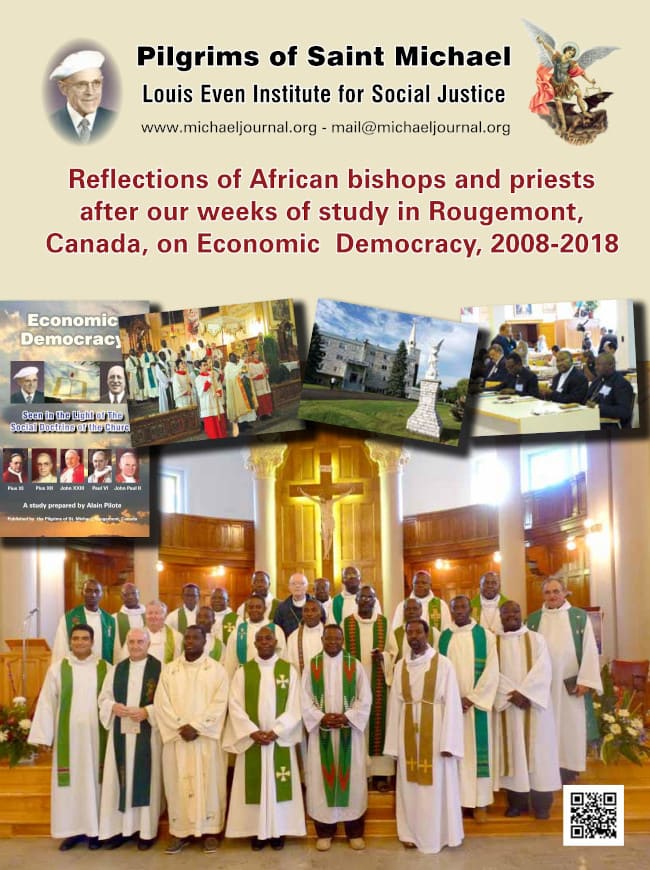 Reflections of African bishops and priests after our weeks of study in Rougemont, Canada, on Economic Democracy, 2008-2018
Reflections of African bishops and priests after our weeks of study in Rougemont, Canada, on Economic Democracy, 2008-2018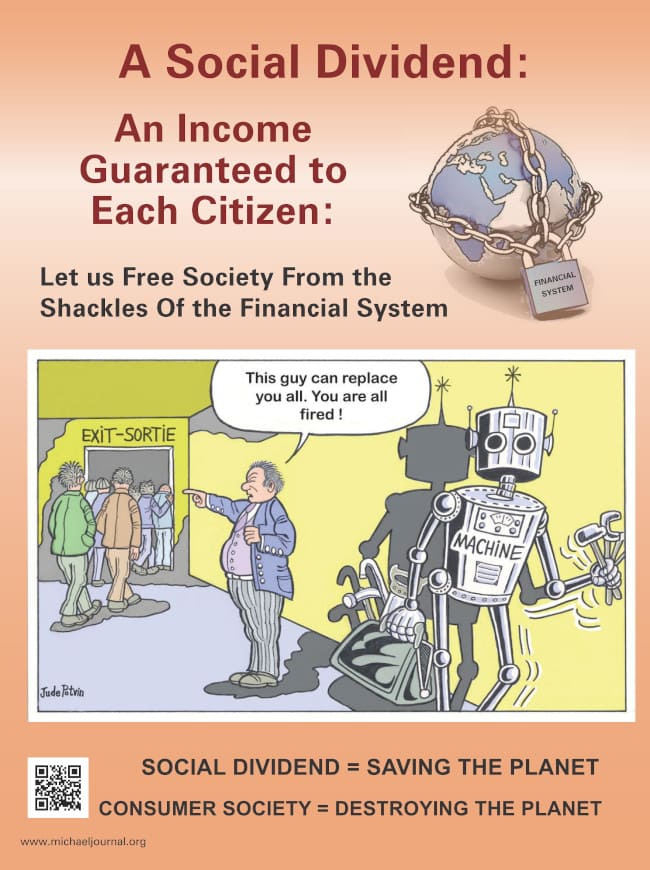 The Social Dividend is one of three principles that comprise the Social Credit monetary reform which is the topic of this booklet. The Social Dividend is an income granted to each citizen from cradle to grave, with- out condition, regardless of employment status.
The Social Dividend is one of three principles that comprise the Social Credit monetary reform which is the topic of this booklet. The Social Dividend is an income granted to each citizen from cradle to grave, with- out condition, regardless of employment status.Rougemont Quebec Monthly Meetings
Every 4th Sunday of every month, a monthly meeting is held in Rougemont.